
For nearly six decades, McDonald’s has called the northwest corner of Madison Street and Minor Avenue home. But all that is soon to change. Development company Holland Partner Group has teamed up with Ankrom Moison Architects, Inc. to redevelop the 15,360 square foot lot. Holland has a vision for 17-story mixed-use building that will tower over the heart of Pill Hill. The project, known as 1001 Minor Avenue, will be a welcome addition the neighborhood and local streetscapes by filling in a big gap.

The McDonald’s building was first constructed in 1956 as a one-story, drive-through restaurant–a common fixture of suburban development of the time. Despite the rapid growth and redevelopment of First Hill a dense neighborhood, this site has managed to stand the test of time with little change since. The site sits at a major crossroads of First Hill’s medical district. Swedish Medical Center and Virginia Mason both call the surrounding blocks home with thousands of staff and even more daily patients and visitors. More than that, this neighborhood is highly desireable for residents, and the diverse, dense population reflects that. This comes as little surprise given First Hill’s amazing foot-oriented infrastructure, historic character, and proximity to large employment centers and services.
Holland hopes to capitalize on these neighborhood features by constructing 16 floors of residential over one floor of retail and lobby space, and 3 floors of underground parking. The type of residential units haven’t be disclosed yet, but Holland intends to create at least 200 units. A further 5,200 square feet will be dedicated to the commercial and retail space at the ground floor. The architects have designed the commercial space to front primarily along Madison Street. The intention here is to get the most public exposure of the retail spaces from the busier street while also directing and generating more activity on it–a real win-win. Minor Avenue will also be addressed by the retail space, but to a much lesser degree. The residential entrance and parking garage will instead form the majority of the Minor Avenue frontage.
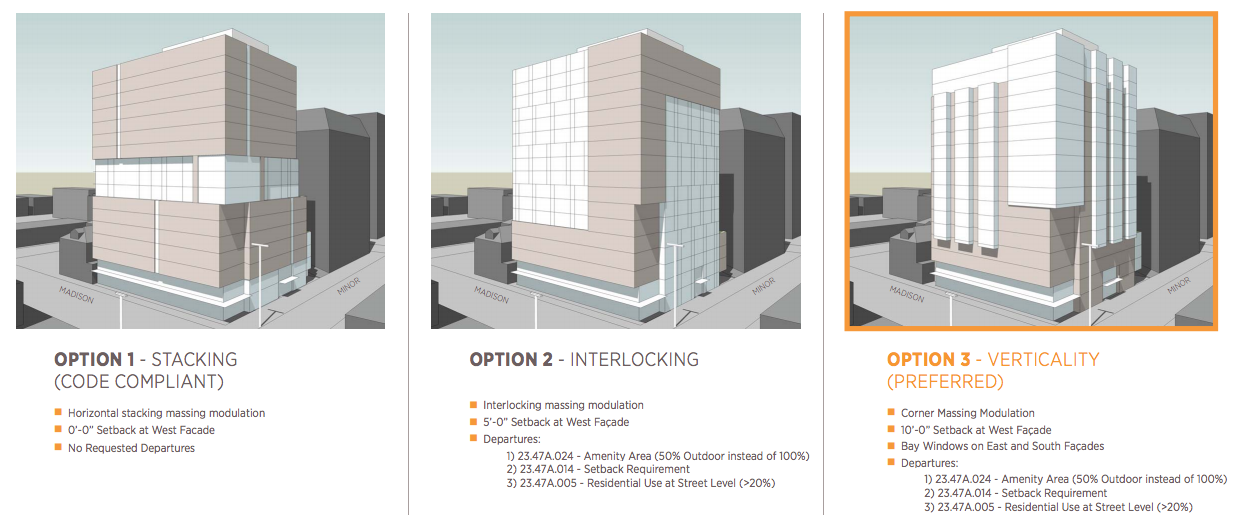
Holland has is analyzing three different design options that they’re calling “stacking”, “interlocking”, and “verticality” in their first round of Design Review Early Design Guidance. Verticality is the preferred option and appears to have the most potential for visual interest from the public realm. Of course, in the massing stage, it is always difficult to imagine how materials and other features might further shape a building.
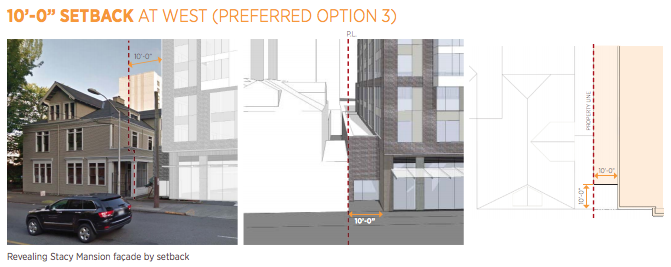
Holland’s architects have carefully considered the towering Gainsborough residential building to the north and the Stacy Mansion to the west in the project design. While neither building is a registered historic structure, they both appear to qualify as such. Ankrom Moison has worked to ensure that the proposed tower will give the adjacent buildings ample breathing room to take their place in the public realm while maximizing the remaining development site. For instance, in the verticality option, Ankrom Moison would stepback the tower above the first floor adjacent the Stacy Mansion while taking advantage of the rest of the potential building envelope under code.
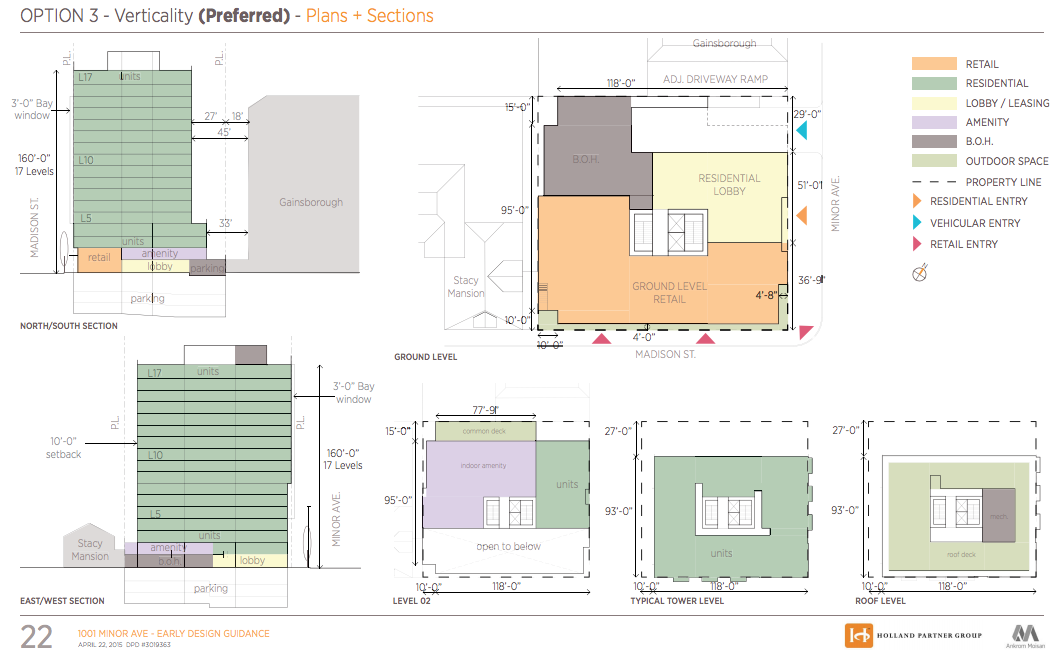
Holland wants to achieve a high quality design that will garner the prestigious LEED certification for sustainable engineering and construction. Certification comes in four forms with projects achieving the highest certification under Platinum guidelines. Holland says that they’re planning to shoot for the basic level of Certified. However, despite the desire to be green, the building will have a fairly high parking ratio of 0.63 stalls per dwelling unit. In total, 126 parking stalls will be provided while 34 to 37 bike parking spaces will be accommodated on the site.
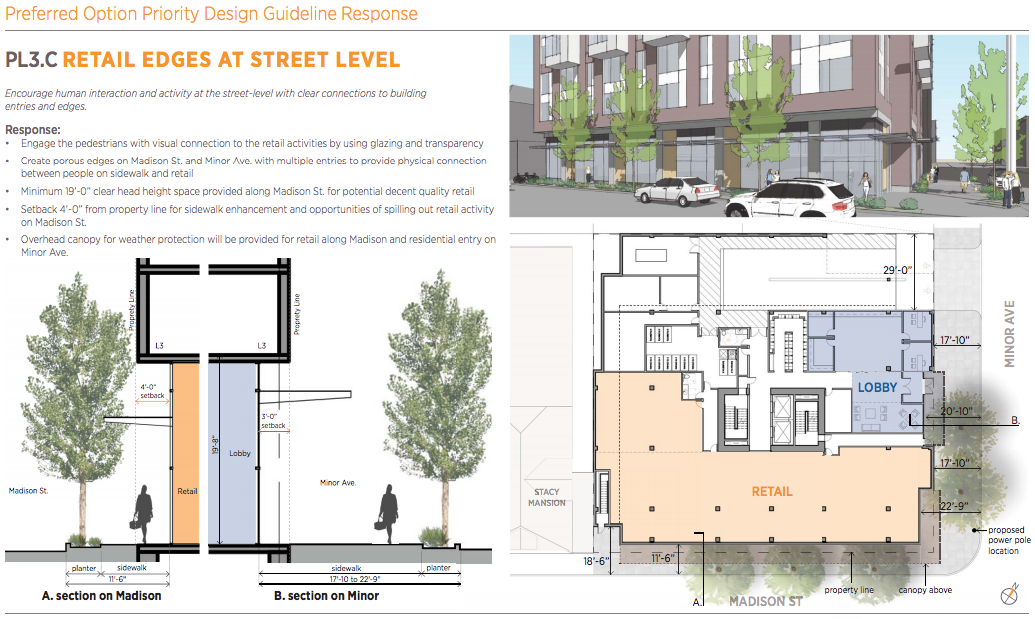
Streetscape improvements will be made to both Madison Street and Minor Avenue. To give pedestrians more room to walk along Madison Street and access the building, the building will be setback a little more generously than today’s McDonald’s. In total, 11.5 feet of sidewalk space will be provided on this frontage while Minor Avenue will have a much deeper setback of 17 feet–despite being the less active street. This may seem like the exact opposite of what should be, but it is in keeping the with the local streetscapes as they are today. The Madison Street right-of-way is tighter than Minor Avenue only because of its priority and orientation to arterial car-based traffic while Minor Avenue acts as a local residential street. Both streets have the same amount of right-of-way (66 feet), but the allocation of space is what ultimately sets them apart.
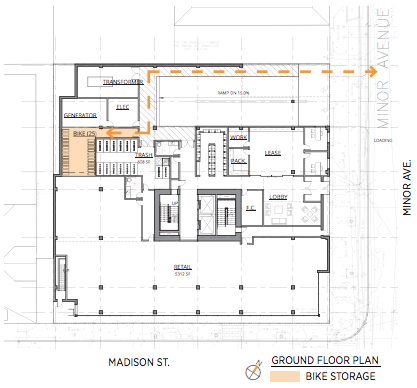
A feature worth noting is the bike parking incorporated into the proposed tower. Holland wants to provide some semblance of security and ease of access to residents with bikes. Using the same entryway as the parking garage, residents will be able to access a secured bike room located on the west side of the ground floor with storage available for up to 25 bikes. Access to this space will also be possible from the residential elevator/lobby area and retail corridors, which should bring bikes on a more equal footing to cars.
Holland is requesting three separate departures from the land use code regarding amenity space, setbacks to adjacent buildings, and additional residential use on the ground floor. The applicant makes very compelling arguments for the Design Review Board and DPD staff to consider. The applicant proposes to place more than half of the requirement amenity space indoors so as to give residents a place to effectively recreate. Indeed, the majority of the rooftop will have green and open space, but the land use code still requires a considerable amount of amenity space above and beyond this. Therefore, the applicants are requesting a departure for more than 50% of the amenity space to be enclosed.
A second departure has been requested for setbacks of floors above 40 feet. Under the land use code, a 2-foot setback would have to be provided for every additional 10 feet of height above the initial 40 feet. This would dramatically reduce the development potential by creating a 27-foot setback on the most upper floor. The final departure requests to allow a greater amount of residential-oriented uses on the ground floor. The proposed residential lobby and leasing area count toward this and would exceed the 20% maximum under code. The applicant argues that this use along the frontage would enhance security and safety while also responding to the quieter nature of Minor Avenue.
Besides the requested departures, the project itself conforms to the general land use code requirements, which permit structures up to 160 feet in height (the site is zoned NC3P-160). The project will have its first Design Review meeting tonight with further refinements taking shape in the coming months in response to the East Design Review Board’s recommendations and comments.
How To Get Involved
If you’re interested in attending the community design review meeting for this project, you can do so tonight. The East Design Review Board will meet at Seattle University in the Admissions & Alumni Community Building, located at 824 12th Avenue. The design review meeting begin promptly at 6.30pm. Alternatively, if you wish submit comments in written form, you can do so by e-mailing BreAnne McConkie, Project Planner, at BreAnne.McConkie@seattle.gov and the Department of Planning and Development (DPD) at PRC@seattle.gov.
For more design review materials and upcoming meetings, see DPD’s design review page.
Stephen is a professional urban planner in Puget Sound with a passion for sustainable, livable, and diverse cities. He is especially interested in how policies, regulations, and programs can promote positive outcomes for communities. With stints in great cities like Bellingham and Cork, Stephen currently lives in Seattle. He primarily covers land use and transportation issues and has been with The Urbanist since 2014.


